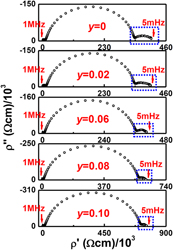Article contents
Resistance degradation behavior of Zr-doped BaTiO3 ceramics and multilayer ceramic capacitor
Published online by Cambridge University Press: 03 April 2013
Abstract

Resistance degradation of zirconium (Zr)-doped barium titanate (BaTiO3) was investigated. A series of Ba(Ti1−yZry)O3 powders and coarse-grained ceramics ranging y from 0 to 0.1 were prepared. The increase of Zr concentration systematically increased the time to as well as electric field to degradation. Such behaviors directly corresponded to those of ionic conduction contribution as evaluated by the Warburg impedance. The magnitude of Warburg impedance decreased with the increase of Zr concentration, which demonstrates that the Zr incorporation inhibits the ionic conduction caused by oxygen vacancies. The prototype multilayer ceramic capacitor (MLCC) samples were also prepared by applying these Ba(Ti1−yZry)O3 base powders and formulated X5R additives of commercial application. In this case, however, such distinct difference in degradation behavior with the variation of Zr concentration did not appear. It is supposed that the influence of additives far outweighs the effect of relative difference in the ionic conduction of Ba(Ti1−yZry)O3 under the MLCC test condition where the applied electric field strength is much higher than those for the coarse-grained bulk ceramics. Resistance degradation of MLCC under such high field might not be explained by only oxygen vacancy-related behavior alone.
- Type
- Articles
- Information
- Copyright
- Copyright © Materials Research Society 2013
References
REFERENCES
- 8
- Cited by




